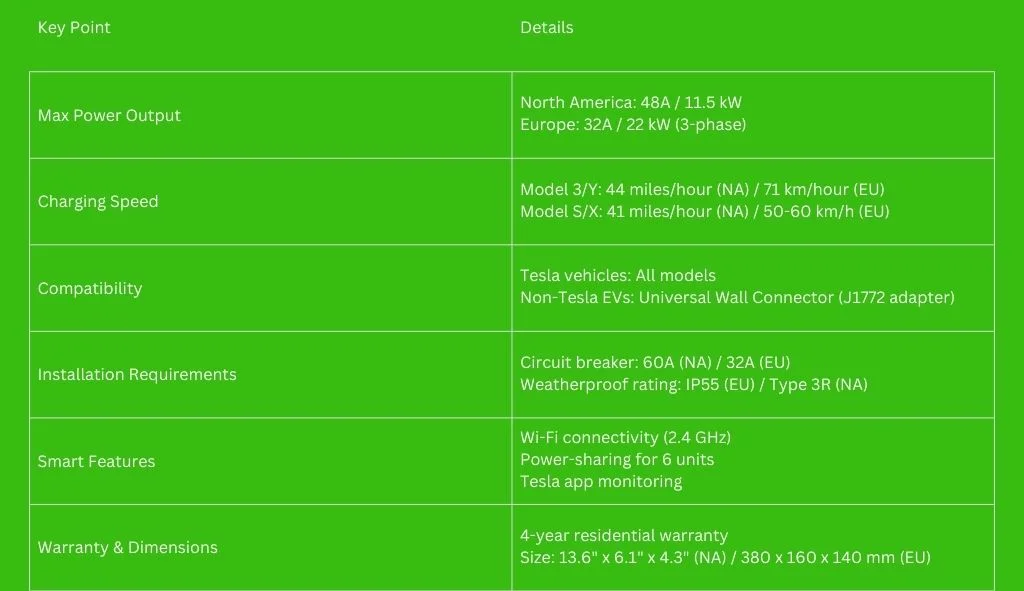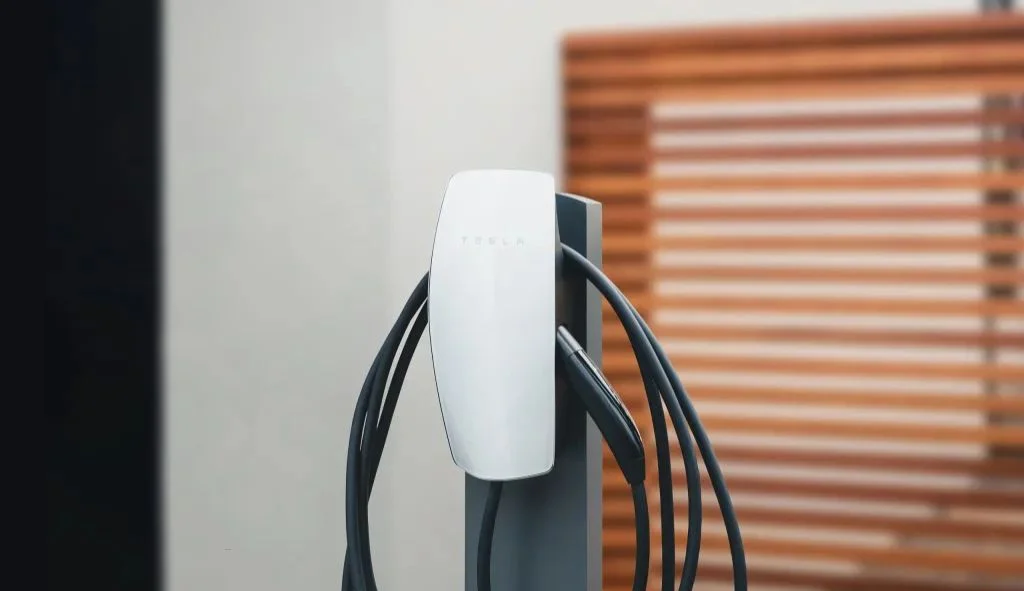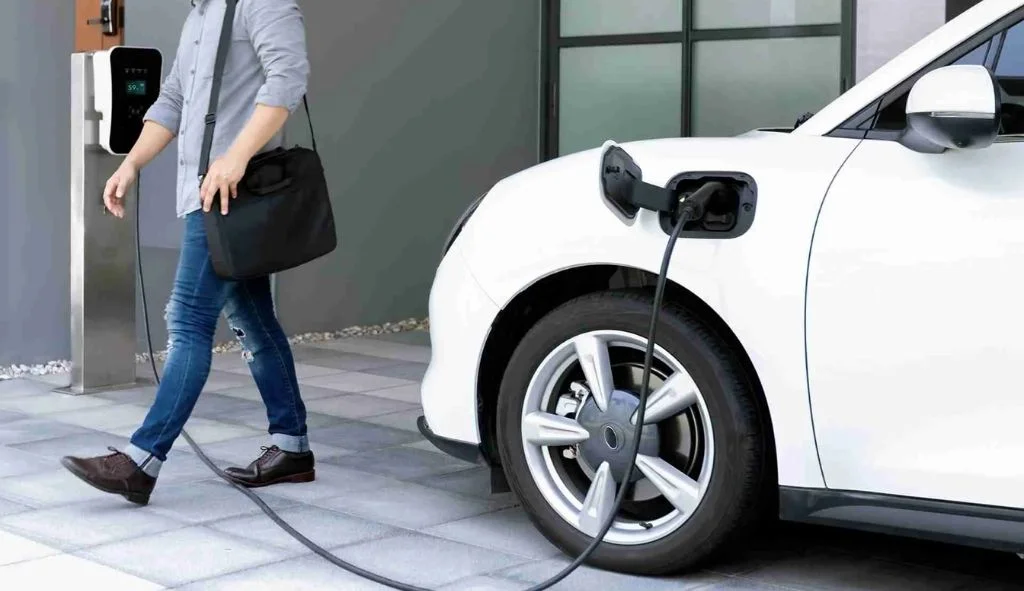The Tesla Wall Connector specification sheet details electrical performance (up to 48A/11.5kW), physical dimensions, connectivity features, and installation requirements for optimal home charging of Tesla vehicles.
Understanding Tesla Wall Connector Models
The Tesla Wall Connector has evolved through several generations, each offering improvements in design, functionality, and charging capabilities. These wall-mounted charging units provide Tesla owners with reliable and efficient home charging solutions that significantly outperform standard electrical outlets.
Gen 3 Wall Connector
The latest generation of Tesla’s charging solution represents the most advanced home charging option available directly from Tesla. The Gen 3 Wall Connector features a sleek, modern design with enhanced smart features and improved performance metrics.
Key features of the Gen 3 Wall Connector include:
- Wi-Fi connectivity for remote management
- Power-sharing capabilities with up to six Wall Connectors
- Auto-sensing handle to open the vehicle charge port
- Monitoring and management through the Tesla app
- Compatibility with both single-phase and three-phase power
- Versatile indoor/outdoor design with weatherproofing
- Variable amperage configurations to accommodate different electrical setups
The Gen 3 model maintains Tesla’s commitment to combining functionality with aesthetic appeal, resulting in a charging solution that not only performs efficiently but also looks appropriate in residential settings.
Previous Generation Wall Connectors
Prior to the Gen 3, Tesla offered the High Power Wall Connector (HPWC) which had a maximum rating of 20 kW or 80 amps at 240 volts. This model was particularly powerful for residential charging solutions but required substantial electrical infrastructure to support its maximum output capacity.
The second-generation Wall Connector reduced the maximum amperage to 72 amps while maintaining the sleek design and core functionality. These earlier models lacked some of the smart features found in the current generation but provided reliable charging capabilities that many Tesla owners still use today.
Universal Wall Connector
In addition to its standard Wall Connector, Tesla now offers a Universal Wall Connector designed to work with non-Tesla electric vehicles. This variant includes an integrated J1772 adapter, making it compatible with virtually all electric vehicles in the North American market.
The Universal model offers the same basic specifications as the standard Gen 3 Wall Connector but adds cross-brand compatibility, positioning Tesla as a provider of charging infrastructure beyond its own vehicle ecosystem.
Technical Specifications
Understanding the technical specifications of Tesla Wall Connectors is essential for proper installation planning and optimal usage. These specifications vary slightly between regions due to different electrical standards.
Electrical Specifications
The North American Gen 3 Wall Connector offers:
- Nominal voltage: 200-240V AC single-phase
- Maximum current output: 48 amps (adjustable by installer)
- Maximum power output: 11.5 kW
- Frequency: 50/60 Hz
- Grounding scheme: TN/TT
- Terminal blocks supporting 12-4 AWG copper wiring
The European/International Gen 3 Wall Connector features:
- Nominal voltage options:
- 1-phase 230V L-N
- 3-phase 230V L-L
- 3-phase 400V L-L
- Maximum current: 32 amps (adjustable by installer)
- Maximum power output: Up to 22 kW (three-phase installation)
- Frequency: 50/60 Hz
- Grounding scheme: TN/TT/IT
- Integrated residual current detection
Both versions include built-in ground fault protection, with the North American model featuring integrated CCID20 (Charge Circuit Interrupting Device) protection and the European model including Type A + DC 6 mA residual current detection.
Physical Dimensions and Design
The Gen 3 Wall Connector’s compact design makes it suitable for various installation locations while maintaining a premium look that aligns with Tesla’s brand aesthetics.
North American model dimensions:
- Height: 13.6 inches (345 mm)
- Width: 6.1 inches (155 mm)
- Depth: 4.3 inches (110 mm)
- Wire box bracket dimensions: 9.8 × 4.7 × 2.0 inches
- Weight (including bracket): 15 pounds (6.8 kg)
European model dimensions:
- Height: 380 mm
- Width: 160 mm
- Depth: 140 mm
- Top entry bracket dimensions: 275 × 130 × 50 mm
- Weight (including bracket): 9 kg
The Wall Connector features a tempered white glass faceplate that provides both aesthetic appeal and protection. LED indicators on the front display charging status and connectivity information, allowing users to quickly assess the operational state of the unit.
Cable and Connector Details
The standard cable length for the Gen 3 Wall Connector is 24 feet (7.3 meters), providing ample reach for most garage or driveway installations. The cable is designed to remain flexible even in cold weather conditions, facilitating ease of use year-round.
North American models use the Tesla proprietary connector that works with all Tesla vehicles, while the Universal Wall Connector includes an integrated J1772 adapter for compatibility with non-Tesla EVs. European models come with a Type 2 (IEC 62196) connector standard for that market.
The connector includes an auto-sensing feature that can automatically open compatible Tesla vehicles’ charge ports when brought near, enhancing the convenience of the charging process.
Operating Conditions
Tesla designs its Wall Connectors to function reliably in a wide range of environmental conditions:
- Operating temperature range: -30°C to 50°C (-22°F to 122°F)
- Storage temperature range: -40°C to 85°C (-40°F to 185°F)
- Enclosure rating: IP 55 (European) or Type 3R (North American)
- Suitable for both indoor and outdoor installation
- No additional ventilation requirements
These environmental specifications ensure the Wall Connector can be installed in various climates and locations, from hot desert environments to cold northern regions, without compromising performance or safety.
Installation Requirements
Proper installation is critical for the safe and efficient operation of the Tesla Wall Connector. While the unit is designed for straightforward installation, Tesla requires that a qualified electrician perform the work to ensure compliance with local electrical codes and safety standards.
Electrical Requirements
The electrical requirements for the Wall Connector depend on the desired charging speed and the specific model:
- Dedicated circuit required
- Circuit breaker sizing options: 15A, 20A, 30A, 40A, 50A, or 60A
- The circuit breaker should be rated for 125% of the Wall Connector’s maximum continuous load
- For maximum charging speed (48A), a 60A circuit breaker is required
- Copper wiring rated for the installation (typically 6 AWG for maximum output)
- For three-phase installations (European), proper phase balancing should be considered
The Wall Connector includes an internal rotary switch that allows electricians to adjust the maximum operating current to match the installed circuit capacity. This flexibility enables installations on various circuit sizes while maintaining electrical safety.
Mounting and Placement
Optimal placement of the Wall Connector considers several factors:
- Proximity to the vehicle’s charging port when parked
- Cable reach to all potential parking positions
- Height for convenient access (typically 45-48 inches from ground level)
- Protection from physical damage (away from vehicle travel paths)
- Avoidance of excessive heat sources or water exposure
The installation manual provides detailed mounting instructions, including a cardboard template for marking drilling locations. The mounting process typically involves:
- Securing the mounting bracket to the wall
- Connecting electrical wiring
- Configuring amperage settings
- Attaching the main unit to the bracket
- Securing with mounting screws
- Installing decorative screw covers
Wiring Configurations
The Wall Connector supports multiple wiring configurations to accommodate different electrical systems:
- Standard single-phase 240V connection (L1, L2, Ground)
- Split-phase 208V connection from three-phase systems
- Three-phase 400V connection (European model)
- Single-phase connection from three-phase supply
The installation manual provides detailed wiring diagrams for each configuration. For European installations, the Wall Connector can be wired in several ways:
- 230V single-phase with neutral
- 230V single-phase without neutral
- 230V three-phase without neutral
- 400V three-phase with neutral
Each configuration has specific terminal connections detailed in the installation documentation to ensure proper functionality and safety.

Smart Features and Connectivity
The Gen 3 Wall Connector includes advanced smart features that enhance the charging experience and provide users with greater control over their energy usage.
Wi-Fi Capabilities
The Wall Connector includes built-in Wi-Fi connectivity with these specifications:
- 2.4 GHz wireless network compatibility (not compatible with 5 GHz or 6 GHz)
- IEEE Standard: 802.11b/g/n only
- Security Type: WPA2-CCMP/AES only
This connectivity enables several important functions:
- Over-the-air firmware updates to improve functionality
- Remote diagnostics for troubleshooting
- Integration with the Tesla mobile app
- Power management features
- Access controls for shared installations
Setting up Wi-Fi requires completing the commissioning process after installation, where the user connects the Wall Connector to their local network using the Tesla app.
Tesla App Integration
Integration with the Tesla mobile app provides users with comprehensive control and monitoring capabilities:
- Real-time charging status and progress
- Charging scheduling to take advantage of off-peak electricity rates
- Energy usage tracking and cost estimation
- Remote charging start/stop functionality
- Charging history and statistics
- Notifications for charging events and completion
This integration allows Tesla owners to manage their vehicle charging seamlessly alongside other vehicle functions within a single application, creating a unified ownership experience.
Power Sharing Features
One of the most advanced features of the Gen 3 Wall Connector is its power sharing capability, which allows multiple Wall Connectors (up to six) to intelligently share a single electrical circuit. This feature is particularly valuable for:
- Multi-vehicle households
- Apartment buildings
- Workplace charging installations
- Properties with limited electrical capacity
The power sharing system dynamically allocates available power among connected vehicles, prioritizing those with lower battery levels while ensuring that the total current draw never exceeds the circuit’s capacity. This intelligent load management eliminates the need for expensive electrical service upgrades in many multi-vehicle scenarios.
Tesla Wall Charger Red Light issue
Performance and Charging Speeds
The primary performance metric for any EV charger is its charging speed, which determines how quickly it can replenish a vehicle’s battery.
Charging Speed by Tesla Model
The actual charging speed achieved depends on both the Wall Connector’s maximum output and the vehicle’s onboard charger capacity:
For North American Tesla models with the Gen 3 Wall Connector at maximum 48A output:
- Model 3: Up to 44 miles of range per hour (11.5 kW)
- Model Y: Up to 44 miles of range per hour (11.5 kW)
- Model S: Up to 41 miles of range per hour (11.5 kW)
- Model X: Up to 35 miles of range per hour (11.5 kW)
For European Tesla models with three-phase power at 32A:
- Model 3: Up to 71 km of range per hour (22 kW)
- Model Y: Up to 71 km of range per hour (22 kW)
- Model S: Up to 50-60 km of range per hour (depending on onboard charger)
- Model X: Up to 50-60 km of range per hour (depending on onboard charger)
These rates make it possible to fully charge most Tesla vehicles overnight, even from a nearly depleted battery state.
Range Added Per Hour
The Wall Connector’s charging speed can also be expressed in terms of range added per hour at different circuit breaker sizes:
| Circuit Breaker | Maximum Output | Model 3/Y Range/Hour | Model S Range/Hour | Model X Range/Hour |
|---|---|---|---|---|
| 60A | 48A / 11.5 kW | 44 miles | 41 miles | 35 miles |
| 50A | 40A / 9.6 kW | 37 miles | 34 miles | 29 miles |
| 40A | 32A / 7.7 kW | 30 miles | 27 miles | 23 miles |
| 30A | 24A / 5.7 kW | 22 miles | 21 miles | 17 miles |
| 20A | 16A / 3.8 kW | 15 miles | 14 miles | 12 miles |
| 15A | 12A / 2.8 kW | 11 miles | 10 miles | 9 miles |
This relationship between circuit size and charging speed allows users to understand the practical implications of different installation options based on their driving needs.
Comparison with Other Charging Methods
The Wall Connector offers significant advantages over alternative charging methods:
Compared to standard 120V outlet (Level 1):
- Wall Connector: Up to 44 miles of range per hour
- 120V outlet: 2-5 miles of range per hour
- Advantage: 9-22× faster charging
Compared to public Level 2 stations:
- Wall Connector: Up to 44 miles of range per hour
- Public Level 2: Typically 25-30 miles of range per hour
- Advantage: Convenience of home charging plus potentially faster rates
Compared to Tesla Supercharger:
- Wall Connector: Up to 44 miles of range per hour
- Supercharger: Up to 1,000 miles of range per hour
- Tradeoff: Much slower but significantly less expensive electricity cost and greater convenience for daily charging
For most owners, the Wall Connector provides an optimal balance of charging speed and installation cost for regular daily charging needs.
Compatibility
Understanding the compatibility of Tesla Wall Connectors helps users make informed decisions about their charging infrastructure investments.
Tesla Vehicle Compatibility
The standard Wall Connector is compatible with all Tesla vehicle models:
- Model S (all years and variants)
- Model 3 (all years and variants)
- Model X (all years and variants)
- Model Y (all years and variants)
- Cybertruck
- Future Tesla models
Older Tesla vehicles (pre-2021 Model S/X) use a different charge port design in North America but are still compatible with the Gen 3 Wall Connector without adapters.
Non-Tesla EV Compatibility
The standard Tesla Wall Connector is designed primarily for Tesla vehicles, but Tesla has expanded compatibility options:
- In North America, the Universal Wall Connector includes an integrated J1772 adapter for non-Tesla EVs
- In Europe, the Wall Connector uses the standard Type 2 connector, making it compatible with most European EVs
- Tesla offers a CCS Combo 1 adapter for Tesla vehicles to use public CCS chargers
With the introduction of the Universal Wall Connector and Tesla’s move to open its charging network to other manufacturers, Tesla is positioning its charging equipment as a standard for the broader EV market.
Pricing and Warranty Information
Understanding the financial aspects of purchasing and owning a Tesla Wall Connector helps users make informed decisions about their home charging setup.
Cost Analysis
The current pricing for Tesla Wall Connectors:
- Standard Gen 3 Wall Connector (North America): $420
- Universal Wall Connector (North America): Higher price point
- Gen 3 Wall Connector (Australia/Europe): $800 AUD/€475
Additional costs to consider:
- Professional installation: $500-$1,500 depending on electrical requirements
- Electrical service upgrades if needed: $1,000-$5,000
- Permit fees: Varies by location
- Potential tax incentives or utility rebates: Up to 30% of costs in some regions
When comparing total cost of ownership, home charging with a Wall Connector typically costs 3-4 times less per mile than public charging options, resulting in significant savings over the life of the vehicle.
Warranty Coverage
Tesla provides comprehensive warranty coverage for the Wall Connector:
- Four-year warranty for residential installations
- One-year warranty for commercial installations
- Covers manufacturing defects and electrical failures
- Does not cover damage from improper installation
- Does not cover normal wear and tear or cosmetic damage
The warranty period begins from the date of installation or 180 days after shipping, whichever comes first. Warranty claims require proof of purchase and are handled through Tesla’s service centers or online support system.
FAQs
Do I need a qualified electrician to install a Tesla Wall Connector?
Yes, Tesla requires installation by a qualified electrician. This ensures compliance with local electrical codes, maintains safety standards, and preserves warranty coverage. Improper installation could lead to electrical hazards, reduced performance, or damage to the charging equipment and vehicle.
What is the difference between the Wall Connector and Mobile Connector?
The Wall Connector is a permanent home charging solution offering faster charging speeds (up to 48A/11.5kW), while the Mobile Connector is a portable solution with lower charging speeds (up to 32A/7.7kW) that can plug into various outlets using adapters. The Wall Connector also offers smart features like app integration and power sharing that the Mobile Connector lacks.
Can I install the Wall Connector outdoors?
Yes, the Wall Connector has an IP55 rating (European) or Type 3R rating (North American), making it suitable for outdoor installation. It’s designed to withstand rain, snow, and temperature extremes from -30°C to 50°C (-22°F to 122°F). For outdoor installations, proper mounting and weatherproof electrical connections are essential.
How many miles of range will I get per hour of charging?
With a maximum output Wall Connector installation, Tesla Model 3 and Model Y vehicles gain approximately 44 miles of range per hour, Model S gains about 41 miles per hour, and Model X gains about 35 miles per hour. The actual rate depends on your vehicle model, battery condition, ambient temperature, and electrical installation.
Can multiple Tesla vehicles share one Wall Connector?
While multiple vehicles cannot charge simultaneously from one Wall Connector, up to six Wall Connectors can be networked together to share a single circuit through the power sharing feature. This allows multiple vehicles to charge efficiently without requiring separate electrical circuits for each connector.
Is the Wall Connector eligible for tax credits or incentives?
In many regions, the Wall Connector and its installation may qualify for tax credits, rebates, or incentives. In the United States, the federal tax credit currently allows for 30% of the cost of charger equipment and installation (up to certain limits). Many utility companies and local governments offer additional incentives for EV charging infrastructure.
How does charging speed compare between 240V Wall Connector and standard 120V outlet?
The Wall Connector operating at 240V/48A charges approximately 9-22 times faster than a standard 120V household outlet. While a 120V outlet provides only 2-5 miles of range per hour of charging, the Wall Connector can provide up to 44 miles per hour, making overnight charging practical even for longer daily commutes.
Can I control when my car charges to take advantage of lower electricity rates?
Yes, through the Tesla app you can set scheduled charging times to align with off-peak electricity rates. This feature, combined with the Wall Connector’s smart capabilities, allows you to program your vehicle to start charging at specific times when electricity costs are lower, potentially saving significant money over time.


